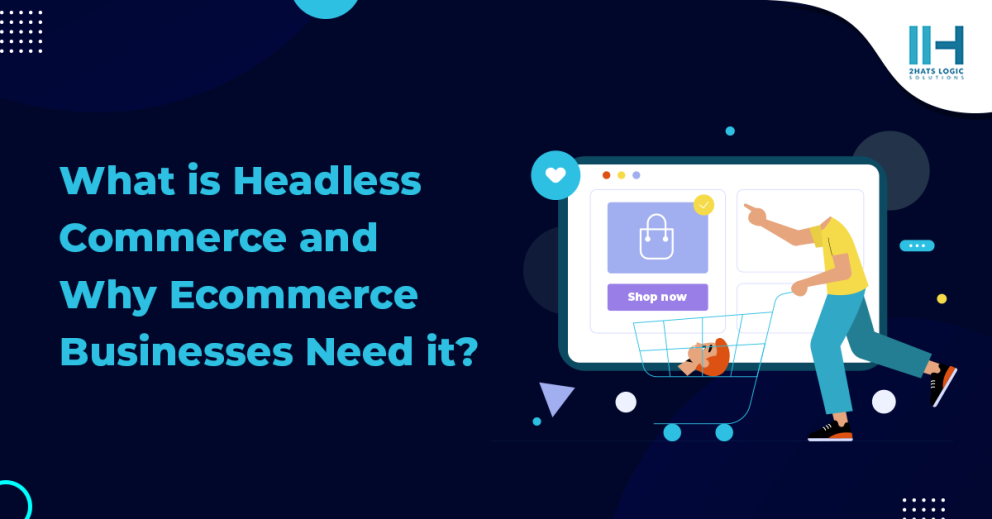Greetings! I'm Aneesh Sreedharan, CEO of 2Hats Logic Solutions. At 2Hats Logic Solutions, we are dedicated to providing technical expertise and resolving your concerns in the world of technology. Our blog page serves as a resource where we share insights and experiences, offering valuable perspectives on your queries.

During earlier days, eCommerce websites used to get their traffic from desktop users coming from that single website. Now, users can buy a product from their smartphone, Tablet, voice assistant, etc., from different platforms and applications. That is from multiple touchpoints. If you want your eCommerce business to be up to date with the current trends, you should know what headless commerce is and how it can help your business succeed.
What is Headless commerce?
Headless commerce, in simple words, decoupling the front-end from the back-end. This helps developers make changes in the front end without worrying about backend configuration. Headless commerce provides brands with flexibility and freedom to change their business according to the customer’s needs.
Understand that the front end of the application is the visible user interface (products, banners, blogs, etc.), which is decoupled from the back end (servers, databases, middlewares, etc.). The front end is the head, so it is called headless.
Headless commerce provides eCommerce brands with more flexibility to change rapidly according to the market. Nowadays, things are rapidly changing on how a customer buys a product. Amazon provides new ways to explore product information, read reviews, and place orders through Amazon Dash buttons, smart voice assistants, and in-store interfaces. All these are done through headless eCommerce.
How Headless commerce is different from traditional commerce?
In traditional eCommerce platforms, the front end is closely linked with the back end. It can get more complex to maintain the backend when the front end of the system needs changes. Let’s say we are adding a new feature to the application. It would require a lot of time to edit the database, the code, along with changes in the front-end platform.
Headless commerce helps the business change its front end without updating the backend by using API calls. They provide flexibility and agility to change the application according to their customer’s needs.
What are the benefits of headless commerce for an eCommerce Business?
Headless commerce provides your eCommerce business with several benefits.
Flexible Integration
It provides flexible integration. Multiple channels like web-app, POS, mobile app, kiosks can be integrated into your eCommerce service. You can even make changes at any stage in the near or distant future.
Customized UX
It gives your brand freedom to design a unique front-end without worrying about the back-end technology. It helps in customizing your UX according to your customer.
Improve Without Affecting Back-end operations
It will help you receive feedback, test more effectively, and optimize your UX based on data-driven decision-making. Also, you can experiment with the user experience without affecting the backend operations.
What are the drawbacks of headless commerce?
Even though headless commerce can bring a massive change to your business, you have to be aware of the challenges that come along with it.
Support
Your business should have a seamless and scalable web storefront that won’t freeze during high-impact sales seasons else.
Cost
The eCommerce business’s front-end will have to be built from scratch, so the setup time and cost can be high initially. It might be helpful in the long run, but the cost of starting it can be very high.
Limitation
Your CMS might not support some third-party tools. So, make sure that your CMS allows the required tools.
How to implement headless commerce in your eCommerce business?
If you want to implement headless commerce into your business, you have to step back and focus on your business’s customer experience. Compare them with your competitor’s services and get the list of functionalities that you remove from your current business and new ones you want to add.
- You can either build your front end or buy it depending on your business needs and budget.
- Once the front-end is implemented, you can focus on back-end changes without affecting the customer experience.
- Choose a good content management service to maintain the content in your front end.
Conclusion
Headless Commerce has been a buzzword for some time in the eCommerce industry. What you need to know is, headless eCommerce is not in the future, It is now. A lot of brands have adapted to this model and are generating great revenue from it.
Looking for a digital agency to implement a headless commerce strategy or Microservices? 2hats Logic Solutions can help you get started.

Related Articles






